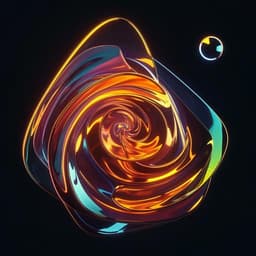
Physics
A chiral one-dimensional atom using a quantum dot in an open microcavity
N. O. Antoniadis, N. Tomm, et al.
Discover groundbreaking advancements in chiral quantum optics as researchers from the University of Basel unveil a single-photon diode with an impressive non-reciprocity of 10.7 dB, demonstrating the power of photon-emitter coupling.
~3 min • Beginner • English
Introduction
The study investigates a chiral one-dimensional atom realized with a quantum dot in a microcavity to achieve non-reciprocal light transport at the single-photon level. In non-chiral systems, a single emitter equally couples to left- and right-propagating modes, yielding reciprocal transmission and reflection. In contrast, a chiral configuration leads to direction-dependent transmission (T1→2 ≠ T2→1). Two limiting cases are highlighted: for β = 1 the atom is perfectly transparent in both directions but imparts a π phase shift in one direction; for β = 1/2, light in one direction is fully transmitted while in the opposite direction it is fully absorbed (scattered into non-waveguide modes). The purpose is to implement and control such chiral behavior using a neutral quantum dot in an open microcavity, enabling a single-photon diode where forward-propagating photons pass while reverse-propagating photons are absorbed. The importance lies in realizing compact, fiber-coupled, highly efficient non-reciprocal photonic devices for quantum technologies, with in situ tunable light–matter coupling (β-factor) and near-transform-limited emitter performance.
Literature Review
Chiral quantum optics with single emitters has previously been realized using atoms coupled to the evanescent field of nanofibers and quantum dots embedded in nanophotonic waveguides, where large β-factors are achievable in nanobeams and photonic crystal waveguides. Chirality is typically engineered by positioning the emitter off-center or exploiting inversion-asymmetric waveguides. The present work departs from these approaches by employing a low-volume one-sided open microcavity, fiber-coupled on both sides, with chirality induced via a magnetic-field-split, circularly polarized transition of a neutral quantum dot. This cavity platform offers controllable enhancement of light–matter interaction (tunable β, up to 99.7% reported previously) and good mode-matching for high-efficiency fiber coupling.
Methodology
Working principle: A polarizing beam splitter and a quarter-wave plate (set at 45°) map forward-propagating light to left-handed polarization and backward-propagating light to right-handed polarization at the microcavity input, creating spin-momentum locking. A magnetic field (Faraday geometry) splits the neutral quantum dot into σ+ and σ− transitions; σ+ couples to the microcavity and is addressed with σ+-polarized photons. The microcavity is one-sided and open: a highly reflective bottom GaAs/AlAs DBR mirror contains InAs quantum dots in an n–i–p diode; a less reflective top dielectric DBR (on a silica crater, radius ~11–12 μm) forms the curved mirror. The open geometry allows precise lateral positioning (XY) of the quantum dot relative to the cavity antinode to tune β in situ, and axial tuning (Z) of the cavity length to bring the σ+ exciton and cavity into resonance.
Operating conditions and modeling: Transmission is defined from port 1 to 2 (forward) and 2 to 1 (backward). In the forward direction T1→2 ≈ 1 ideally, as the field is orthogonal to the dot’s dipole (no interaction). In the backward direction, the field interacts with the σ+ transition; the transmission amplitude is T2→1 = 1 − 2β (empty-cavity β-factor), with full transmission T2→1 = 1 − 2β^2. In the over-coupled regime (β = 1), backward photons acquire a π phase shift; at critical coupling (β = 0.5), destructive interference causes vanishing transmission (photons are scattered into non-cavity modes). The cavity fundamental mode is slightly birefringent (two orthogonal linear modes) with mode splitting ~29 GHz at 945 nm, smaller than the cavity linewidth κ/(2π) = 102 GHz, so the mode is nearly degenerate. Losses are dominated by the top mirror (κ_top ≫ κ_bottom). Residual mode splitting acts as an overall loss channel (insertion loss ~1.5 dB) and sets an off-resonant transmission ceiling (~0.7 in their definition excluding setup losses). The device operates at 4.2 K with a 2.0 T out-of-plane magnetic field; the σ+−σ− splitting is ~63 GHz.
Tuning β: By moving the quantum dot laterally, β is tuned. Transmission T2→1 versus dot detuning is measured for different positions, yielding β ≈ 0.72 (centered), β ≈ 0.50 (critical coupling), and β ≈ 0.12 (off-center), with corresponding linewidth changes due to Purcell enhancement. Transmission contrast (1 − T_on/T_off) versus lateral position peaks near β ≈ 0.5 (~0.9). Average spectral fluctuations of the dot are ~40 MHz (from model–data comparison). A comprehensive model for a two-level system coupled to a one-sided (nearly degenerate) microcavity is used for all fits (Supplementary Note 1).
Experimental setup: The bottom mirror is a 46-pair GaAs/AlAs DBR; the top mirror is an 8-pair Ta2O5/SiO2 DBR on a curved substrate (radius ~12 μm). The microcavity is mounted on nanopositioners (ANP101/ANP51, attocube) and addressed with a lens (NA 0.55, Thorlabs 355230-B) inside a helium bath cryostat (4.2 K). A tunable laser (TOPTICA DLC CTL 959) provides excitation. Transmission is detected with a fiber-coupled Si APD (Excelitas SPCM-NIR, η_APD ≈ 44 ± 3%). Photon statistics g(2)(τ) are measured with NbTiN SNSPDs (Single Quantum EOS 210 CS, η_SNSPD ≈ 82 ± 5%) and a Time Tagger Ultra (jitter 9 ps). Overall end-to-end optical throughput is ~56% (corresponding to T = 1 in their normalization).
Key Findings
- Achieved a chiral single-photon diode using a neutral quantum dot in an open microcavity with in situ tunable β. The optimal operating point is β ≈ 0.50 (critical coupling).
- Demonstrated strong non-reciprocity: isolation T1→2/T2→1 ≈ 11.9, corresponding to 10.7 dB. On resonance, forward transmission ≈ 0.82; backward transmission minimized to T2→1 ≈ 0.07 at β ≈ 0.50.
- Off-resonant transmission limited to ~0.7 due to residual cavity mode splitting; insertion loss ~1.5 dB. Cavity linewidth κ/(2π) = 102 GHz; polarization mode splitting ~29 GHz at 945 nm.
- Power-dependent nonlinearity in backward direction consistent with saturation of a two-level system: on resonance, T2→1 increases linearly at very low powers with a critical power Pc ≈ 13 pW (average photon flux ⟨n⟩ ≈ 0.27 per emitter lifetime τ_op = 0.26 ns).
- Photon statistics confirm single-emitter origin: at lowest power (5 pW), backward-transmitted light shows strong bunching g(2)(0) ≈ 101; bunching diminishes with increasing power, approaching g(2)(τ) = 1 at high power. Forward transmission exhibits g(2)(τ) ≈ 1, consistent with non-interacting propagation.
- A single parameter set (β = 0.50, free-space decay rate γ0/(2π) = 300 MHz) quantitatively models all transmission and g(2)(τ) data.
Discussion
The results establish a chiral one-dimensional atom realized with a quantum dot–microcavity platform as an efficient, fiber-coupled single-photon diode operating at cryogenic temperatures and modest coupling (β ≈ 0.5). The measured non-reciprocity and strong photon bunching directly validate single-emitter-mediated direction-dependent absorption and the onset of quantum nonlinear optics at ultralow powers. The agreement between measurements and a canonical chiral atom model confirms that the observed non-reciprocity and nonlinearity arise from coherent light–matter interactions in the engineered chiral configuration. The platform’s tunability (β by lateral positioning; cavity frequency by axial positioning) and high coupling efficiency make it promising for integrated quantum photonics. Potential applications include dynamically controllable non-reciprocal elements (via driving, spin-state control, or fast Stark tuning), single-photon phase shifters, and two-photon quantum gates. The observed strong bunching suggests proximity to two-photon bound-state regimes, enabling exploration of exotic few- and many-body photonic phenomena in chiral waveguide QED.
Conclusion
This work demonstrates a high-performance, fiber-integrated single-photon diode using a neutral quantum dot in an open, one-sided microcavity with in situ β tuning. Operating at the critical coupling point (β ≈ 0.5), the device exhibits strong non-reciprocity (10.7 dB isolation), low-power nonlinearity (Pc ≈ 13 pW), and pronounced photon bunching (g(2)(0) ≈ 101), all captured by a consistent theoretical model. The approach provides a versatile and efficient platform for chiral quantum optics, with clear pathways to advanced functionalities such as dynamic switching, single-photon phase shifting, and two-photon gates. Future improvements include suppressing cavity mode splitting (e.g., electro-optic tuning or uniaxial stress) to reduce insertion loss and approach β → 1, enabling ideal phase-shifter operation and enhanced deterministic photon–photon interactions.
Limitations
- Residual cavity polarization mode splitting (~29 GHz) relative to the cavity linewidth (κ/(2π) = 102 GHz) introduces losses, limits off-resonant throughput (~0.7 in their normalization), and contributes to insertion loss (~1.5 dB), though it does not fundamentally limit non-reciprocity.
- The microcavity must not rotate polarization; residual non-degeneracy effectively acts as a loss channel and complicates perfect polarization control.
- The quantum dot exhibits average spectral fluctuations (~40 MHz), which can broaden features and impact device stability and contrast.
- Operation requires cryogenic temperatures (4.2 K) and an external magnetic field (2.0 T) to achieve circularly polarized transitions and chirality, which may limit practicality and scalability.
- Reported transmissions exclude setup losses in their normalization; absolute end-to-end throughput is ~56%, which can impact system-level efficiency in applications.
Related Publications
Explore these studies to deepen your understanding of the subject.







